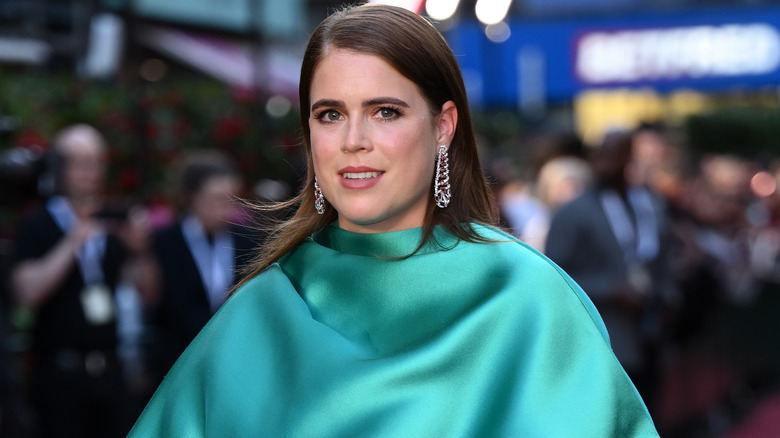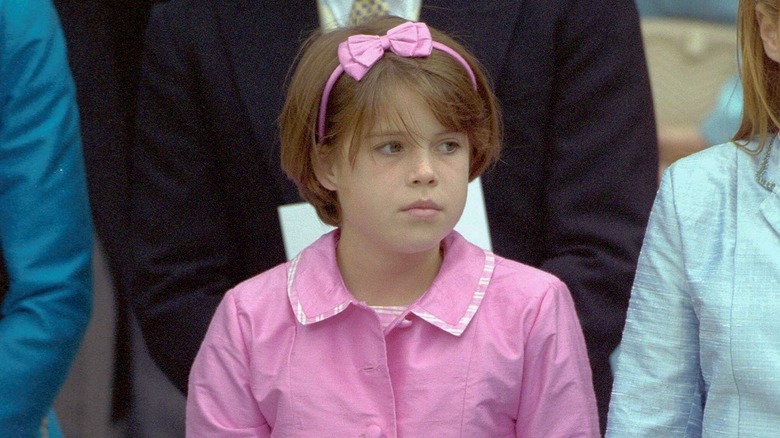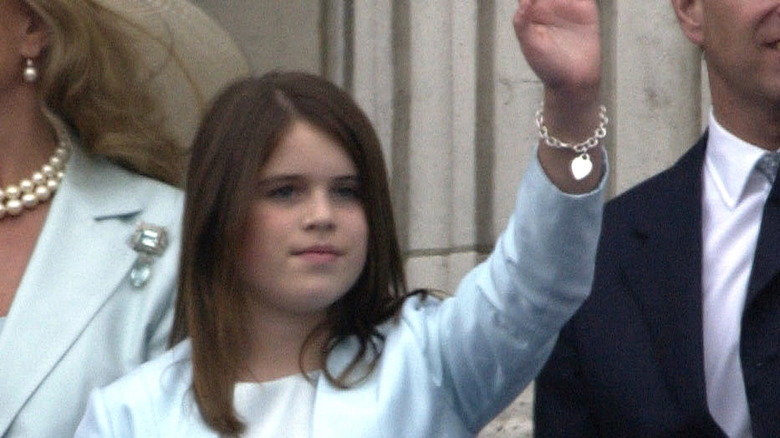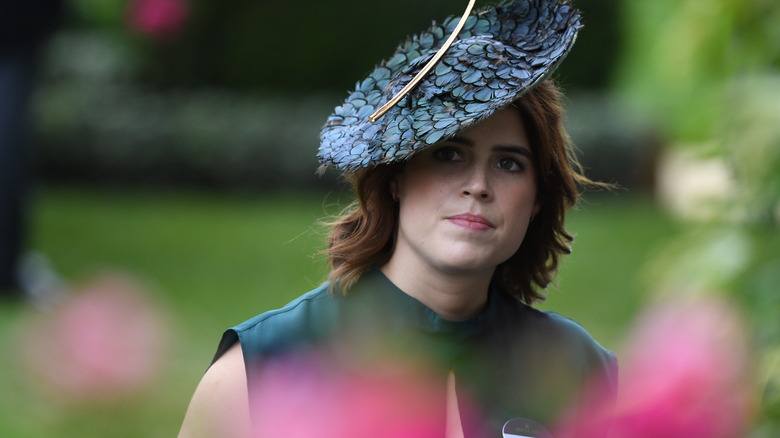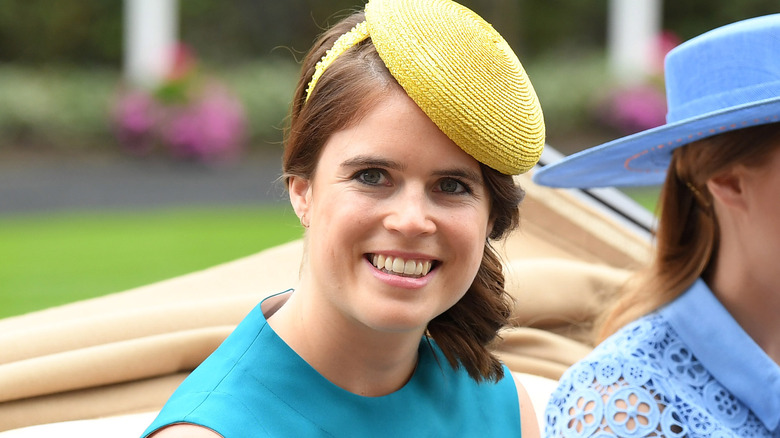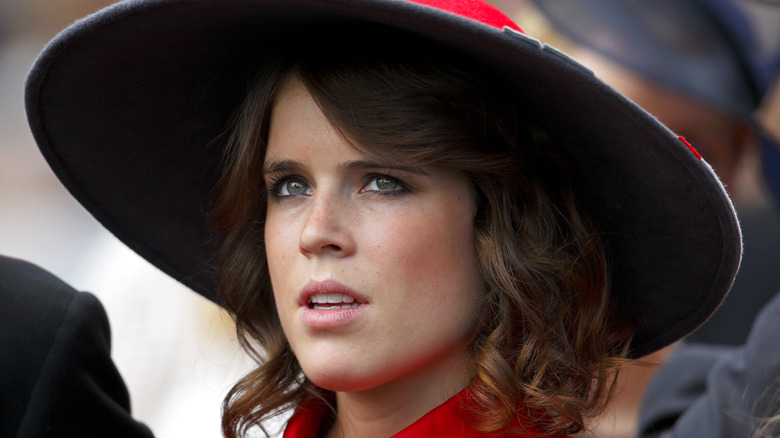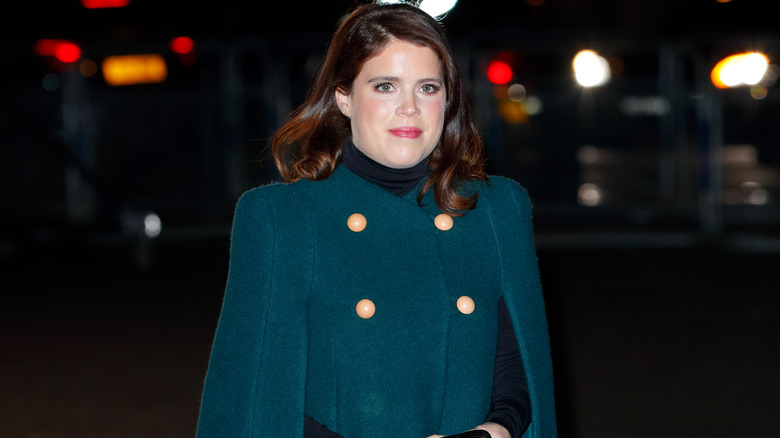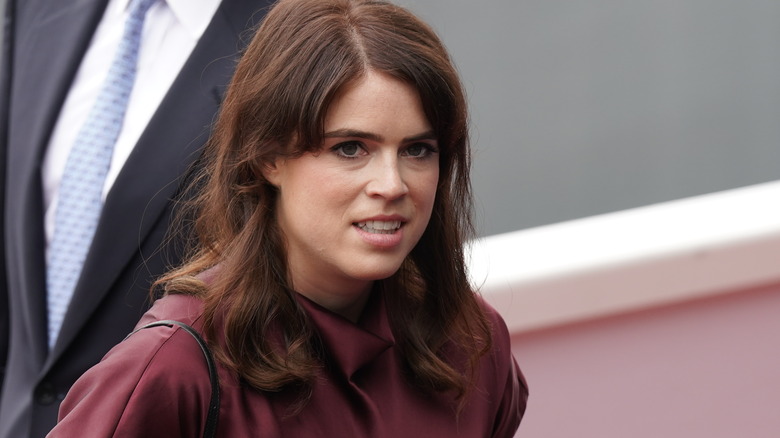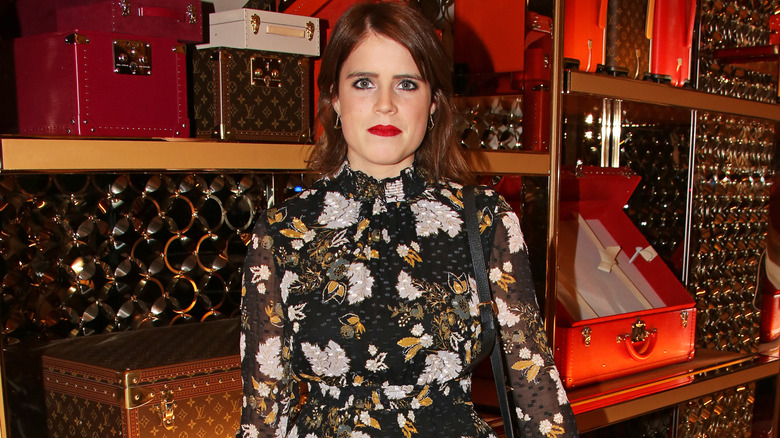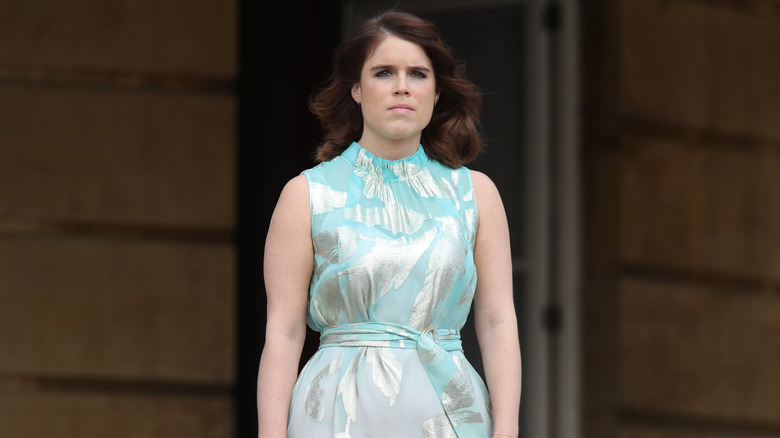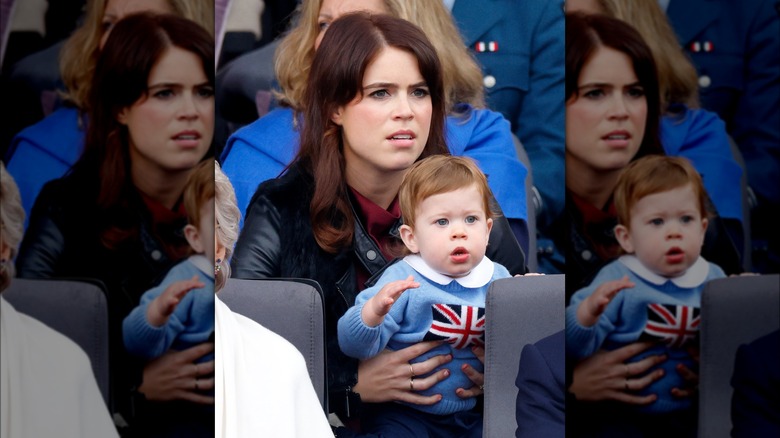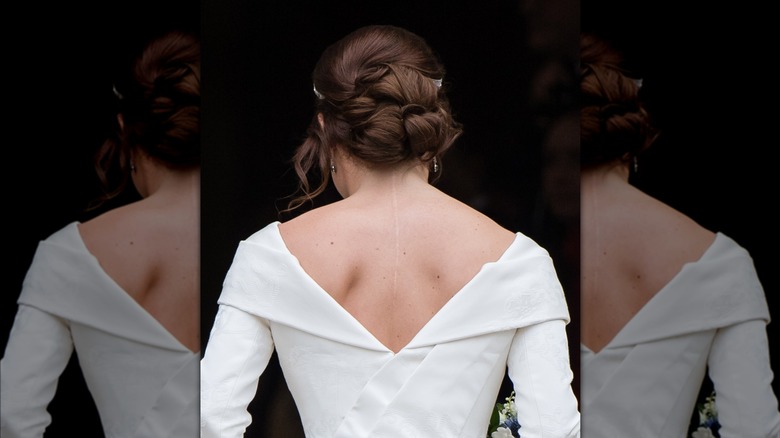Tragic Details About Princess Eugenie's Health Condition
Even if you're not an avid royal watcher, chances are good you've at least heard of Princess Eugenie. She's the daughter of Prince Andrew and Sarah "Fergie" Ferguson, Duchess of York. She has an older sister, Princess Beatrice, and is 11th in line to the throne. Eugenie married her husband, Jack Brooksbank, in 2018, and the couple has two children, August Philip Hawke and Ernest George Ronnie.
Eugenie isn't a working member of the royal family, which means that she actually has time to pursue a career of her own. When she's not enjoying some tea with family members at Buckingham Palace, you'll find her working at the London art gallery Hauser & Wirth as associate director. Despite not being a working royal, Eugenie remains close to senior members of the family, especially Prince Harry. A family insider told People that, despite Harry's move to America, he and Eugenie remain close. "They're still the best of friends and talk constantly," the insider disclosed.
While many envy Eugenie's seemingly magical life, many don't know that she actually lives with a lifelong health condition that required her to undergo surgery when she was still just a child. Eugenie has scoliosis, and it was so bad when she was a kid that doctors recommended surgery to prevent it from getting even worse before she hit adulthood. She has spoken openly about it since and has made many others feel less alone in their diagnosis.
Princess Eugenie was diagnosed with scoliosis when she was 12
When Princess Eugenie was 12 years old, doctors diagnosed her with scoliosis. Eugenie's mother, Sarah, Duchess of York, first noticed something was amiss when she watched her daughter swim, Prince Andrew told the Royal National Orthopaedic Hospital (RNOH). Eugenie was taken to the doctor and received a pretty serious scoliosis diagnosis. "[I was] told that I would need corrective surgery," she wrote in an essay for the RNOH. "This was, of course, a scary prospect for a 12-year-old; I can still vividly remember how nervous I felt in the days and weeks before the operation," she added.
If you're confused about what was actually wrong with Eugenie, here's the lowdown: Scoliosis occurs when a person's spine starts to rotate, causing an unnatural curve to form. Cleveland Clinic explains that the human spine has a natural curve, but thanks to their spine's gradual rotation, scoliosis patients deal with a spine that curves sideways instead of forward and back. The severity of the curve differs from person to person — some experience curves that are as mild as 10 degrees, while others can deal with a curve of up to 100 degrees (and in extreme cases, even more). Often, scoliosis can easily be seen on an x-ray because the spine forms an "S" or "C" shape, Health Central explains.
As you're probably guessing, this unnatural curve can cause plenty of problems, depending on its severity, and in Eugenie's case, it was so extreme that she needed corrective surgery.
Scoliosis can't be prevented and is often hereditary
You're probably wondering whether Princess Eugenie or her parents could've done anything to prevent her scoliosis, and the answer to that is a resounding no. Scoliosis can't be prevented. In fact, doctors are still baffled as to why some types of scoliosis occur in the first place. 80% of people who get diagnosed with this condition have no known cause. This is referred to as idiopathic scoliosis. Johns Hopkins Medicine notes that this type of scoliosis is often diagnosed in children ten years and older — this is on par with Princess Eugenie's diagnosis at age 12. Mayo Clinic explains that idiopathic scoliosis typically runs in families, but there's no known gene that causes it.
Other types of scoliosis include neuromuscular scoliosis and congenital scoliosis. The former is typically a result of one or the other neuromuscular conditions, like spina bifida, cerebral palsy, and muscular dystrophy. Because these conditions affect the muscles around the torso, the risk of developing an unnatural spinal curve is much higher. When the spine's vertebrae don't develop properly, it can lead to congenital scoliosis. This can often be diagnosed in newborn babies.
It might be safe to say that Eugenie was diagnosed with idiopathic scoliosis. It's very likely that either her mom or dad also has scoliosis, or perhaps other members of her family. There are no other known royals with scoliosis, but it might just be that they aren't aware they have it because it's mild.
It can have a very negative effect on self-esteem
Even though signs of scoliosis might not be that obvious at first, noticeable physical signs can occur as the unnatural curve of the spine worsens. The fact that Princess Eugenie's mother could see something was off with her back while she was swimming is a testimony to how severe her scoliosis was. Mayo Clinic notes that one shoulder blade jutting out and uneven shoulders are some of the most common symptoms. Some people's scoliosis can be observed when they bend over and one side of their back sticks out more than the other. Other physical symptoms include an uneven waist, hips, and rib cage. The NHS notes that these physical changes in the body can even cause a person's legs to appear uneven and can make the fit of some clothes look awkward.
While these physical symptoms can already be upsetting enough, the thing that affects children's and especially adolescents' self-esteem the most is wearing a back brace. Not only does it scream to the world that they're different, but it can also limit the clothes they can wear and the activities they can participate in. Princess Eugenie admitted to The Telegraph that she, too, had some self-esteem issues prior to her surgery. "I think the most upsetting [thing was] ... having a condition that made me different." She further explained, "As well as the idea that I would not be at school [after surgery], or be normal like the other students."
Scoliosis can cause extreme chronic pain
Aside from the fact that scoliosis can cause plenty of physical changes to the body, it can also cause extreme pain. Healthline notes that the most common types of pain people experience are stiffness and an ache located in the lower back. Some people even experience shooting pain in their legs. In some cases, the pain becomes so extreme that patients have trouble navigating their day-to-day lives. Fatigue is another annoying symptom alongside the pain.
According to Cleveland Clinic, scoliosis pain can become chronic, and in some cases, it might stop responding to pain medication. This is usually when doctors will start to consider surgical options that will help ease the pressure on nerves in the back caused by the unnatural curve of the spine.
Extreme pain is often a symptom only adults with scoliosis deal with. Children might experience some mild tenderness in their back, but it is unlikely to be bothersome. This is likely why Princess Eugenie and her parents never knew she had scoliosis until her mother noticed the physical signs — she probably never experienced any intense pain. Had she not undergone the surgery, however, she would likely have dealt with chronic pain as an adult. Cleveland Clinic notes that the more scoliosis progresses as people get older, the more painful and disabling it becomes.
Her scoliosis could have severely impacted her life without surgery
While it can seem easier to simply suck up the back pain than undergo surgery, the complications that can arise as scoliosis progresses can be quite severe. Aside from chronic pain, patients can experience other distressing symptoms, like heart failure.
Scoliosis SOS Clinic explains that, as the spine's unnatural curve continues to worsen, it eventually starts to press on the rib cage, decreasing the available space and thus affecting the heart's ability to function properly. Heart failure isn't a common occurrence in scoliosis patients, but it is a possibility if it's left untreated. The restriction of the rib cage can also lead to respiratory problems because the lungs no longer have optimal space to expand. Patients experiencing this will find that they are often short of breath, thanks to decreased lung capacity. Aside from severely affecting the rib cage, untreated scoliosis can also lead to a condition known as lumbar stenosis. This decreases the size of the spinal canal, which affects the nerves in this area and eventually leads to leg pain and weakness.
In an essay she wrote for the Royal National Orthopaedic Hospital, Princess Eugenie admits that had she not undergone surgery for her scoliosis when she did, her life would have been very different. "I wouldn't look the way I do now; my back would be hunched over," she wrote.
Princess Eugenie's recovery after her scoliosis surgery was 'frustrating'
When Princess Eugenie underwent corrective surgery for her scoliosis, she was bed-bound for a couple of weeks, and it left her feeling incredibly frustrated.
Speaking to The Telegraph, Eugenie revealed that she was worried about how the surgery would change the way her body could move. "Will I be able to play sports, or will I look the same, or will I miss a lot of school and be behind?" she recalled thinking at the time. "Afterwards, I couldn't move for a while in hospital or when I came home. I had to wear a neck brace and be moved very gently in bed for a few months. That was very frustrating and I remember being angry about not being able to run and play," she added. When she finally went back to school, these limitations continued, but she kept believing that, once she fully recovered, she would be able to do those things again.
Eugenie's concerns as a kid mirror those of many other scoliosis patients. According to the Scoliosis SOS Clinic, there are plenty of sports you can't do when you have scoliosis — weight lifting, dance, gymnastics, yoga, impact sports, and one-sided sports (think golf, tennis, and skiing) are off the table for many because they can pose significant risks. With that said, it is possible to continue with these sports under the right guidance. Post-surgery, however, it's recommended that you stick to low-impact, gentle exercises like swimming, cycling, and yoga.
Extreme scoliosis can only be improved with surgery, which is quite expensive
The surgery Princess Eugenie had at the age of 12 is known as spinal fusion, and while it's said to be highly effective, it's also incredibly expensive.
When performing spinal fusion surgery, surgeons fuse implants like bone grafts, hooks, screws, and steel rods with the spine to straighten it, Healthline explains. "My surgeons inserted eight-inch titanium rods into each side of my spine and one-and-a-half inch screws at the top of my neck," Eugenie explained in an essay she wrote for the Royal National Orthopaedic Hospital. These days, other forms of surgery that are less invasive exist. The bright side is that recovery time is shorter when you opt for these procedures, but the risks and complications outweigh that of spinal fusion.
When it comes to cost, a 2017 study published in the Journal of Spine Surgery notes that it has become increasingly expensive to undergo corrective surgery for scoliosis. In 1997, the procedure cost $55,000. By the time 2012 rolled around, it had gone up to $177,000. This hefty price tag can make it challenging for some people to scrape together the money to address severe scoliosis, especially those without health insurance. Of course, prices vary depending on where you live and who your surgeon is.
She completed her surgery without lasting complications, but it's a risky procedure
When undergoing surgery to correct scoliosis, there are always risks to keep in mind. Healthline warns that some people experience complications that lead to blood clots, vision loss, and even nerve or neurological damage. There's also a risk of muscle or dural tears, gastrointestinal or digestive issues, and respiratory problems. Medtronic notes that some patients' spine doesn't properly fuse with the implants, which prevents healing.
There's also the risk of malfunctioning implants. Additionally, some patients experience vertebral degeneration at the surgical sites. A 2015 study published in Scoliosis found that post-surgery infection is very common among patients who undergo scoliosis surgery. Patients who already have another underlying condition may experience additional complications not observed in otherwise healthy patients. The surgical procedure is also a very long one. Speaking in a video for the Royal National Orthopaedic Hospital, Prince Andrew revealed that Princess Eugenie's surgery took eight hours to complete.
Despite all the risks, Eugenie managed to come out the other end without any lasting complications. In the video, Andrew revealed that Eugenie goes for regular checkups. "She was at the Baltimore Street Assessment Center only last week seeing her surgeon and having a checkup, and everything is absolutely wonderful, there's nothing wrong, and it is working as advertised, and the rods are doing their job," he said at the time. So, even though there are plenty of risks, the surgery could be worth it and even life-changing for people with severe scoliosis.
Scoliosis surgery in children or young adults presents unique challenges
Even though Princess Eugenie isn't experiencing any issues with her spinal implants at present, doctors are concerned about the longevity of some of the implants used in spinal fusion surgery. On his website, Tony Nalda, M.D., who is a leading expert in chiropractic care and conservative scoliosis treatment, warns that in patients as young as Eugenie was when she got her surgery, it can be difficult to say how the spine's growth process will affect the surgery's results. "The procedure can't offer any guarantees that it will be successful at preventing further progression," he writes. Luckily, in Eugenie's case, the surgery held up.
Another concern Nalda raises is the durability of the implants — or hardware, as he refers to it — that are used to straighten the spine during surgery. "There is a significant gap in the research and data on the long-term effects of spinal fusion 10, 20, and 30+ years down the road," he explains, adding, "The reality is that we quite simply don't know how living with a fused spine will look far into the future." Nalda continues to explain that the hardware used during the procedure does, unfortunately, have an expiration date. The younger a patient is when they undergo surgery, the more likely it is that they might experience "hardware failure" in the future. "I'm referring to screws coming loose and puncturing the spine, rods becoming weaker over time and breaking," he clarifies.
Some people experience chronic pain and restrictions even after surgery
While spinal fusion surgery is supposed to relieve scoliosis symptoms like chronic pain and make some activities and sports more accessible, Tony Nalda, M.D., a leading expert in chiropractic care and conservative scoliosis treatment, warns that he's seen plenty of cases where patients still suffer from pain and physical limitations post-surgery. This is because of how spinal fusion changes the body. "As a fused spine is held in place by artificial means, it's not only less flexible, it's also weaker and more prone to injury," Nalda notes, adding, "In addition, the fused vertebrae and lack of movement affect the surrounding muscles that support the spine; they become strained and tight."
Because of this, people who undergo spinal fusion may find that they have very limited movement through their back. This, in turn, can cause physical limitations that keep them from participating in certain activities and sports. Nalda explains that, because the spine is more prone to injury after the surgery, many patients are too scared to try new activities for fear of hurting themselves. This can have an adverse effect on people's ability to live a carefree life and might make them feel as if they are still being hampered by their scoliosis. Princess Eugenie, however, is still often seen hitting the slopes with her sister, Princess Beatrice, when they go on their annual ski holiday, so for some, it is possible to enjoy activities they love post-surgery.
Scoliosis surgery can affect sexual health
The two might seem completely unrelated, but there is evidence that scoliosis surgery can affect sexual health and even cause sexual dysfunction. Spinal News International notes that it's well known that anterior spinal surgery, which is often the method used to correct scoliosis, has been proven to cause retrograde ejaculation in men. When it comes to how this surgery affects women, however, research is still sparse.
A small 2017 study consisting of 22 women who underwent corrective surgery for adolescent idiopathic scoliosis (as Princess Eugenie did) found evidence that these women were more likely to experience symptoms of sexual dysfunction than other women their age who hadn't undergone the surgery (the study included women who were between the ages of 19 and 38, with the average age being 28). Common complaints from participants included a decline in orgasms, sexual arousal, and sexual satisfaction. The study notes that more research needs to be conducted to determine whether the surgery itself caused these symptoms or if scoliosis is the root cause.
Spinal News International adds that sexual changes are prevalent in around 30% of women who undergo scoliosis surgery. The outlet also notes that some early studies indicate that 40% of women experience altered menstrual cycles post-surgery. Unfortunately, in-depth research is yet to be conducted on how scoliosis surgery affects women's sexual health long-term, which, given the day and age we're living in, is scandalous.
Scoliosis surgery affected her option of a natural birth
Aside from having an effect on women's sexual health, scoliosis surgery can also present women with unique challenges when it comes to pregnancy.
It appears that Princess Eugenie didn't have the option of a natural birth for either of her two pregnancies. A source told People at the time that doctors performed a C-section to deliver her first baby because of the princess' scoliosis surgery. This isn't always the case, however. Board-certified OB/GYN Jane Minkin, M.D., told People that it really depends on the patient and how exactly their spine was altered during surgery. In some cases, a natural birth is possible, but an epidural can't be administered thanks to the placement of the rods. This can make labor more challenging.
In an article chiropractic expert Tony Nalda, M.D., wrote for the Scoliosis Reduction Center, he explains that, typically, patients with scoliosis aren't necessarily predisposed to pregnancy-related risks. Some women might experience increased back pain while others don't experience any back pain at all — it differs from person to person. When it comes to labor, however, some complications could arise. "For women whose scoliosis has caused crooked hips, there can be an increased number of stalls during labor as the baby can end up malpositioned," Nalda explains. "For cases of scoliosis where the spinal curvatures are extreme, potential additional complications include intense back pain and difficulty breathing due to lung impairment," he added.
Princess Eugenie has embraced her scarring from scoliosis surgery
There's no getting around scarring when you undergo scoliosis surgery. In Princess Eugenie's case, her surgery left a long noticeable scar down her back. For many, this can be distressing and severely affect their self-esteem. Spinal News International notes that this issue is prevalent in women, especially during their adolescent years. Those who undergo anterior lumbar interbody fusion also have scars on their stomach, which is a concern for most women.
Princess Eugenie, however, decided that she would show off her scar instead of hiding it. Speaking to The Telegraph, the princess revealed that she wanted a wedding dress with an open back, and she wasn't about to let her scar keep her from making that dream come true when she married Jack Brooksbank in 2018. When she was younger, however, she might've forfeited her dream dress in favor of hiding her scar. She admitted that she used to hide it and tried her best to make it go away. "I remember putting cream only on my scar for years after the operation," she said.
Eugenie eventually realized showing it off was helping others embrace their own scars. "I believe scars are like memories that tell a story on your body, that remind you how strong you had to be, and that you survived to talk about it," she said, adding, "Be proud of the story you can tell and inspire people with."
